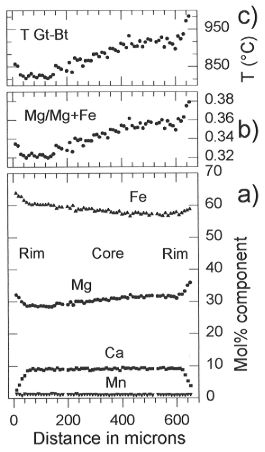

The interpretation of textural and compositional variations within a single sample, or single mineral phase, is critical to the success of petrological investigations in non-equilibrated rocks. This is because the accurate determination of multiple stages along pressure-temperature-time evolution paths is only possible where phases, or phase compositions, recording and preserving a former equilibrium stage, can be correctly pinpointed. Attempts at geothermometry in two granulite samples from the Bohemian Massif illustrate this nicely.
Granulite facies rocks are those formed at high temperatures and one of the features of such rocks in many parts of the world is that they show textural and chemical equilibrium corresponding to these high temperature conditions. Compositional zoning in minerals formed during the prograde path to the temperature maximum is generally completely homogenised and all remaining zoning results from later cooling. Of course, if zoned minerals were not homogenised, utilising core compositions for geothermometry - assuming cores represent the parts of grains least affected by later cooling - leads to meaningless results. Zoning in a large garnet from a garnet-clinopyroxene granulite from Lower Austria (Fig. 3.4-3a) shows a significant difference between core and rim reflected also in Mg/(Mg+Fe) along the same profile (Fig. 3.4-3b). Temperatures determined by combining matrix clinopyroxene with each point along the profile (Fig. 3.4-3c) are lowest in the core and highest close to rim with a slight decrease at the absolute rim. Thus, although this sample shows a texturally equilibrated matrix, garnet compositional zoning was not homogenised during this clearly high temperature metamorphism. Assuming that cores preserved the highest grade part of the history of this rock would be a serious misinterpretation.
In the second example, a felsic granulite from Southern Bohemia, geothermometry
is possible utilising garnet-biotite Fe-Mg exchange. The compositional
profile in this much smaller garnet (Fig. 3.4-4a) is unusual in that two
types of zoning are present: 1) loss of Ca at rims counterbalanced by a
rise in Fe and Mg and 2) a larger scale Fe-Mg variation reflected in a
sloping Mg/(Mg+Fe) value (Fig. 3.4-4b). The effect this compositional variation
has on temperatures determined by garnet-biotite geothermometry, taking
the core composition of a matrix biotite, is shown in Fig. 3.4-4c. In contrast
to the previous example, the remarkable temperature difference of over
200°C (between 800 and 1000°C) is not the difference between core
and rim values but is in fact a sloped profile. What this is telling us,
is that in this case garnet composition from a peak temperature stage is
being reset to a composition controlled by garnet-biotite Fe-Mg exchange
at a lower temperature. Biotite occurs in a position corresponding to the
left side of Fig. 3.4-4 and is thus dragging Mg/(Mg+Fe) down to a new value
consistent with an equilibrium temperature close to 800°C. Cooling
from high temperatures in this case most likely took place under essentially
fluid-free conditions. For this reason, modification of garnet composition
is strongly controlled by absolute distance from communicating, exchanging
phases and not, as is more usual, a simple product of distance from garnet
rim.
 |
 |
|
Garnet-clinopyroxene granulite, Lower Austria. a) Compositional zoning,
b) Mg/ (Mg+Fe) for the same profile, c) temper-atures deduced from garnet-clino-pyroxene
geothermometry by combining a single matrix pyroxene composition with each
garnet composition along the profile.
|
Felsic granulite, S Bohemia. a) Compositional zoning, b) Mg/(Mg+Fe)
for the same profile, c) temperatures deduced from garnet-biotite geother-mometry
by combining a single matrix biotite composition with each garnet composition
along the profile.
|
In both these cases it is necessary to make a careful interpretation of garnet zoning in order to be able to determine meaningful temperatures by geothermometry. Simply assuming that high grade conditions homogenises phases is not always valid and likewise, assuming that compositional modification during post-peak temperature cooling occurs from grain margins towards interiors, can sometimes lead to serious errors.

Tel: +49-(0) 921 55 3700 / 3766, Fax: +49-(0) 921 55 3769, E-mail: bayerisches.geoinstitut(at)uni-bayreuth.de
 Previous page
Previous page